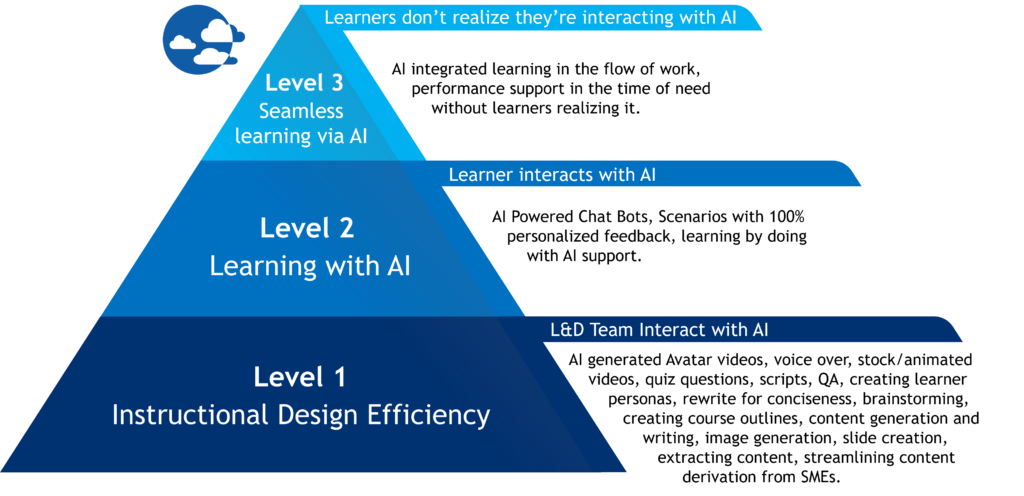A Three-Tiered Approach To AI Integration

Embracing AI Use To Transform L&D Processes And Workflows
Drawing from the rich insights I’ve gleaned from an AI and L&D community of practice, it’s evident that the application of Artificial Intelligence in Learning and Development is multifaceted and evolving. Some L&D professionals adeptly incorporate AI to advance and optimize their workflows. Simultaneously, a pioneering segment is exploring AI’s transformative potential, venturing into innovative applications. The versatile impact of AI in L&D is clear through its varied adoption, offering opportunities from incremental enhancements to ground-breaking transformations.
The Need To See Beyond The Short-Term
However, as the integration of Artificial Intelligence (AI) into Learning and Development (L&D) gradually gains momentum, there remains a palpable sense of hesitation. Despite the promising potential of AI, many in L&D are treading cautiously, focusing primarily on “easy-to-grasp” applications that enhance existing practices rather than revolutionizing them. This cautious approach, often dictated by enterprise limitations and a wariness of uncharted technology, results in a limited exploration of AI. This is further exacerbated by the AI limitation difference between vendors vs. in-house teams. Recognizing this gap, I have conceptualized a three-tiered framework of AI use in L&D, aimed at guiding the industry from initial, comfortable applications to more ground-breaking and transformative learning methodologies.
Harnessing AI In L&D: A Three-Level Approach
AI’s integration into L&D can be viewed through a three-tiered lens:
- Level 1 (Instructional Design efficiency)
- Level 2 (Direct learning with AI)
- Level 3 (Seamless learning via AI)
Each level represents a unique approach to incorporating AI. The range includes enhancing the efficiency of Instructional Design, directing learner interaction with AI, and finally, integrating AI so seamlessly that learners are unaware of its presence.

Level 1 AI Use In L&D: Instructional Design Efficiency
At this initial stage, L&D teams interact directly with AI tools to streamline and enhance the Instructional Design process. This involves using AI to generate avatar videos, voiceovers, and even stock or animated videos. AI also plays a pivotal role in creating quiz questions and scripts and conducting quality assurance. Another effective example is creating learner personas [1]. AI also aids in rewriting content for conciseness, brainstorming ideas, creating course outlines, and ensuring smooth transitions in content.
Moreover, AI contributes significantly to content writing, image generation, and slide creation. A vital component of this level is the extraction and streamlining of content derived from Subject Matter Experts (SMEs). By doing so, AI not only enhances the efficiency of the Instructional Design process but also ensures that the content is relevant, concise, and engaging.
Level 2 AI Use In L&D: Learning Directly With AI
The second level of AI integration in L&D focuses on the learners interacting directly with AI tools. This includes AI-powered chatbots [2] that facilitate learning and provide support. One of the most innovative aspects at this level is the creation of scenarios with 100% personalized feedback. Learners receive directly relevant feedback, significantly enhancing the learning experience.
Another aspect of this level is learning by doing with AI support. This method allows learners to engage actively with the content, applying what they have learned in real time with the guidance and support of AI. This hands-on approach reinforces learning and helps learners understand the practical application.
Level 3 AI Use In L&D: Seamless Learning Via AI
The final level represents the pinnacle of AI integration in L&D. At this stage, AI is so intricately woven into the learning process that learners do not realize they are interacting with AI. This level focuses on AI-integrated learning in the flow of work. In this scenario, work is completed more efficiently and effectively, with AI providing performance support at the time of need.
The key to success at this level is the seamless integration of AI. Learners receive the support and guidance they need without the conscious realization that AI is facilitating their learning process. This approach enhances the learning experience and ensures learners can apply their knowledge and skills in real-time work environments.
Conclusion
The integration of AI in L&D represents a shift in how learning is designed, delivered, and experienced. From enhancing Instructional Design efficiency to enabling direct learner interaction with AI, and ultimately achieving seamless learning integration, AI is redefining the boundaries of L&D. As we continue to explore and harness the potential of AI in learning, we are not only enhancing the effectiveness of L&D initiatives but also paving the way for a more adaptive, personalized, and efficient learning landscape.
References
[1] Harnessing Technology for Efficient Learner Persona Creation [2] Talk to Me: Using Chat Bots for Learning 
Beyond the Sky
We infuse learning with marketing principles for learning that sticks. We uniquely combine leading edge marketing experience to change behavior with modern learning techniques to change learner behavior!
Originally published at www.beyondthesky.ca.
Source link



